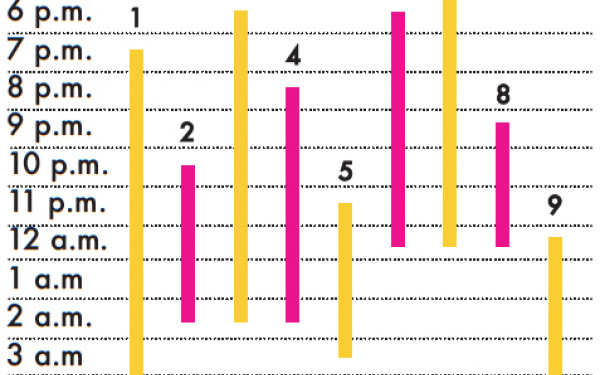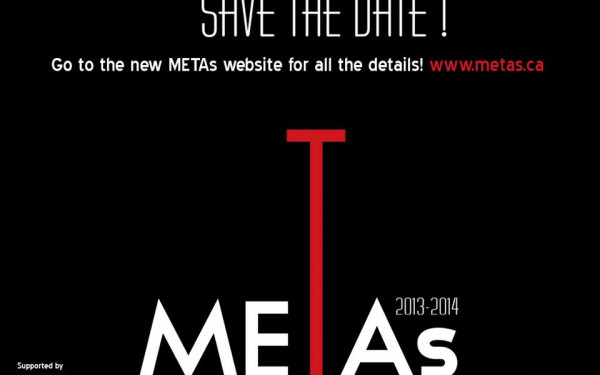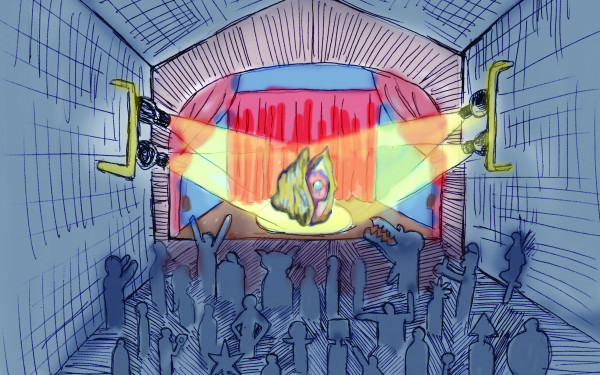What’s For Dinner? Western Imperialism
While Rats Eat Pie Brings the Tragedy of War to the Dinner Table
A group of 13 individuals eat dinner with a PTSD-suffering war journalist, downing shots of liquor from the Eastern Bloc, eating pie, and discussing the dissolution of the former Yugoslavia. Although everyone at the table is part of a play, only one of them is an actor—in this production, to spectate is to participate. While Rats Eat Pie fully immerses its cast-audience hybrid in the fallout of what has moved from the tragic to the historical.
While Rats Eat Pie is the brainchild of Colin Lalonde, artistic director of Studio Porte Bleue. With the help of his friend and former classmate Chris Bell, both alumni of the International Performance Research program at the University of Warwick, he put together a piece that reflects his experiences in Serbia.
“The reaction to how the West intervened [in Yugoslavia] is still a fraught issue,” Lalonde told The Link by phone. “The reality is that hubris is still something to think about in this global context,” he said, referencing American intervention in the Middle East.
The intimate atmosphere created by the limited number of guests leads invariably to “in-depth conversation” over the pie served at the end of the piece.
Bringing food into the performance added an element of unpredictability.
“I wanted to see what would happen if smell and taste were introduced to storytelling,” Lalonde told The Link. “In a fun way, I wanted to lose a little bit of control.”
A post by Bell to the studio’s blog highlights the importance of the food chosen for the dinner party. Each course is imbued with “multiple layers of meaning and historical significance.”
“Each seemingly everyday item is shifted and infused with an idea, allowing for the spectator’s thoughts and questions to resurface,” Bell wrote. “Cutting a loaf of bread may lead to a criticism of biased journalism or Western intervention. Drinking a glass of wine could leave you wondering what resources are available to war correspondents with PTSD.”
Bell admitted that practicing for the performance wasn’t just about finding the right symbolism to pair with a tin of canned meat.
“Infusing the day-to-day routine of cooking with stories of tragedy and joy has required us to physically choreograph the performance, which has forced me to reexamine and push myself in the realm of physical theatre,” Bell explained.
“To be quite honest, physical theatre is an area that I have navigated with a great amount of awkwardness throughout my career as a tall and lanky performer.”
He added that Lalonde’s methods, which focus on movement in theatre, helped him “acquire methods for bodily explorations of the text, space, and food preparation.”
Food wasn’t the only unpredictable element in the performance. Reactions to Bell’s performance varied widely among audience members.
If most attendees know each other, the nights tend to be “boozy” and social, whereas a table of strangers lends itself “either to connections being made or a kind of silence and awkwardness.” But when dessert is served guests invariably engage in discussion, sometimes staying until 11:30 p.m.—four hours after the performance’s beginning—to discuss the issues the play brings up, said Lalonde.
The script for the performance had originally leaned towards the genre of dark comedy, but as the writing process progressed Bell and Lalonde began to take the narrative more seriously.
“We were surprised by how many people would laugh during the performance,” Lalonde admitted. “But if you’re not laughing you’re crying. [We realized] it’s just human to not want to delve too deeply into psychological trauma.”
Some people wanted to get up from the table and stop Bell from doing certain particularly emotive things during his performance, or get up and give him a hug, but stopped themselves before interrupting the narrative flow.
A war that popular consciousness has made into a matter of objective reflection highlights Bell’s personal struggle “to maintain his hold on reality,” as the piece’s website describes.
The performance is the latest in a series of interactive performances and installations by Studio Porte Bleue. According to their mandate, they aim to “nurture mutually beneficial creative relationships between those who view art and those that create it.”
The response to While Rats Eat Pie has been overwhelmingly positive, said Lalonde, resulting in sold-out shows. The studio has added two performances, one of which, on Nov. 1, still has spots available.
While Rats Eat Pie // Oct. 26 to Nov. 1 // Tickets can be booked in advance through studioportebleu.com or at 514-772-8071 // $30

_777_1050_90.jpg)
_600_832_s.png)


_600_375_90_s_c1.jpg)

